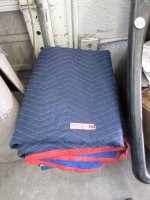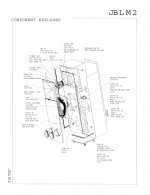Tried stuffing them for test. Doesn't sound like cab is stiff enough to be optimal in that mode.
Generally, the GD will be improved but loss of bass output. Cabinet should be stiff enough at your preferred power/listening level.
-Richard
RNM,
As I suspect you are aware I take little here seriously.
I currently have a 6 part article on linear power supplies going in Aydioxpress. Most of which was discussed here years ago when I was doing the research. Next up I may do one on fuses as was discussed here also.
The most recent circuit technique shown here was how to use a resistor to reduce the value of the DC blocking capacitor in a feedback loop.
Of course the bits about resistor and capacitor selection are now reasonably well known.
Now your request has actually brought out a few more bits of interest.
Surprisingly I have met younger folks specializing in analog circuitry, however their world is strongly simulation based.
Long long ago, but not far away I used to keep interesting circuit bits on 3x5 cards in a small box in my desk as I came across them.
In bold... that is my purpose... 🙂 and, I/we will look forward to reading about it. i didnt know. maybe others didnt also.
My smart girl asked me which should she specialize in -- digital or analog. She was leaning towards analog and i agreed. there will be need as everyone else is doing digital.
THx- Richard
Last edited:
25mm MDF, at what point does it start flexing and, more to the point, can you hear it?Generally, the GD will be improved but loss of bass output. Cabinet should be stiff enough at your preferred power/listening level.
-Richard
Another good tip.
How about your own circuit tricks?
THx-RNMarsh
...and how about some of yours -exchange being robbery?
Cabinet should be stiff enough at your preferred power/listening level.
One might imagine so. However, I have always preferred the sound with very stiff and well damped speaker cab walls. Don't like sound radiating off the back and sides. Was modding JBL and Altec pro sound cabs back in the early 70's because of that preference. Recently found out Jam also has a long history of modding speaker cabs due to the same perceptual preference. Interesting coincidence that.
Last edited:
25mm MDF, at what point does it start flexing and, more to the point, can you hear it?
i have a test for that... get your self a few of the thick shipping blankets and drape it over the cabinet - sides, top, back. It will absorb most any freq enough to hear a difference. If there is a noticeable diff. then it needs bracing. You can leave them in place and listen if it helps you. But the M2 cabs are a lot better than years ago. They have learned.
quote - JBL's M2 enclosure is made of rigid 1" MDF and is extensively braced for absolute stability at the system's full-rated power. The enclosure employs the patented JBL Slipstream port design with internal flares that give you low-frequency efficiency while eliminating port-turbulence noise.
shipping blankets - Google Search

THx-RNMarsh
Last edited:
i have a test for that... get your self a few of the thick shipping blankets and drape it over the cabinet - sides, top, back. It will absorb most any freq enough to hear a difference. If there is a noticeable diff. then it needs bracing. You can leave them in place and listen if it helps you. But the M2 cabs are a lot better than years ago. They have learned.
shipping blankets - Google Search
View attachment 813848
THx-RNMarsh
Neat trick!
Let me salute this message, the conclusion of which I quote. It offers a lot of ways to think.Accepting the evidence means to accept that we up to now still don't know enough the multidimensional evaluation using music as stimuli to predict results wrt audibility of differences.
About thresholds of audibility, it begins with statistical difference between men and women.
Women have an upwardly shifted bandwidth, including the frequency zone of maximum sensitivity.
Last edited:
Just knock the wall with your finger. Of course, you can hear-it !25mm MDF, at what point does it start flexing and, more to the point, can you hear it?
?? I have many times. One was how to lower speaker driver distortion with only one resistor added to PA.
The question isnt for me but for all to participate. Pls give source info so all can find your 2 mentioned, pls.
-RNM
Can you give a link to the one resistor distortion reducer.
Hans
Just knock the wall with your finger. Of course, you can hear-it !
The M2 cabs are really very well braced. It is like knockng on a concrete wall.
JBL's M2 enclosure is made of rigid 1" MDF and is extensively braced for absolute stability at the system's full-rated power. The enclosure employs the patented JBL Slipstream port design with internal flares that give you low-frequency efficiency while eliminating port-turbulence noise.
-Richard
The M2 cabs are really very well braced.
Mostly it is, except behind the horn. Nice resonance there if tapped on with a finger.
Attachments
Mostly it is, except behind the horn. Nice resonance there if tapped on with a finger.
Blankets. Do it if you need to. I didnt find it an issue for me.
-Richard
Last edited:
Mark,
As I posted before, almost all cabinet vibrations are caused by the reaction forces of the cone/VC assembly accelerating and braking.
Stuffing the pipe will make no difference in that.
Furthermore:
1. above the resonance frequency of a BR loudspeaker, the pipe behaves as if it were not there. Inertia of the air inside the pipe effectively causes the enclosure to behave as if it were closed. It has to, otherwise there would be acoustic shortening between the vent and the driver. There isn't.
2. at the resonance frequency, where pipe acoustic output is highest, the cone hardly moves. The back wave from the pipe is in phase with that of the back of the driver. You can see this in impedance plots as the through between two peaks. At this point, the pressure inside a BR enclosure is higher than inside a sealed enclosure of identical proportions. You can easily verify this for yourself because the air pressure inside a BR enclosure at this point is high enough to put the cone movement to almost a stand still. In the comparable sealed enclosure, the cone will still move at the same frequency.
I am hugely thankful though that you posted this, because it puts all your 'listening observations' exactly where they belong: the dust bin. You made a devastating error Mark, by identifying the lesser vibrating enclosure to be the inferior one. The only suggestion I would have is to further on only trust your ears if it can be backed up by measurements.
As I posted before, almost all cabinet vibrations are caused by the reaction forces of the cone/VC assembly accelerating and braking.
Stuffing the pipe will make no difference in that.
Furthermore:
1. above the resonance frequency of a BR loudspeaker, the pipe behaves as if it were not there. Inertia of the air inside the pipe effectively causes the enclosure to behave as if it were closed. It has to, otherwise there would be acoustic shortening between the vent and the driver. There isn't.
2. at the resonance frequency, where pipe acoustic output is highest, the cone hardly moves. The back wave from the pipe is in phase with that of the back of the driver. You can see this in impedance plots as the through between two peaks. At this point, the pressure inside a BR enclosure is higher than inside a sealed enclosure of identical proportions. You can easily verify this for yourself because the air pressure inside a BR enclosure at this point is high enough to put the cone movement to almost a stand still. In the comparable sealed enclosure, the cone will still move at the same frequency.
I am hugely thankful though that you posted this, because it puts all your 'listening observations' exactly where they belong: the dust bin. You made a devastating error Mark, by identifying the lesser vibrating enclosure to be the inferior one. The only suggestion I would have is to further on only trust your ears if it can be backed up by measurements.
An extreme example, I have well braced U-frame woofers, during testing I drove then very low and loud, they had solid feet and whilst the panel resonances were well above the frequency I was going to be using them, the whole frame twisted quite dramatically. After experimenting with added mass, above and below and panel damping made no difference, I cut up some old sorbothane insoles and used them as feet under each corner, problem totally cured. 🙂i have a test for that...
Sorry, but not at all. it is in phase with the front of the driver. Delayed of one period.2. at the resonance frequency, where pipe acoustic output is highest, the cone hardly moves. The back wave from the pipe is in phase with that of the back of the driver.
Note that I answered in a more gentle manner than the way you did to Mark:
;-)I am hugely thankful though that you posted this, because it puts all your 'observations' exactly where they belong: the dust bin.
Last edited:
An extreme example, I have well braced U-frame woofers, during testing I drove then very low and loud, they had solid feet and whilst the panel resonances were well above the frequency I was going to be using them, the whole frame twisted quite dramatically. After experimenting with added mass, above and below and panel damping made no difference, I cut up some old sorbothane insoles and used them as feet under each corner, problem totally cured. 🙂
 simple and effective.
simple and effective."In addition to being visco-elastic, Sorbothane® also has a very high damping coefficient. Sorbothane® combines shock absorption, good memory, vibration isolation and vibration damping characteristics. ... Sorbothane® has a superior damping coefficient, over a very wide temperature ...
is there a way to use it in contact with speaker walls? and not reduce the effectiveness of the sorbothane?
Or inside....
Aqueous damping paint (DP/DP-F) - Namyang Novitech
Reactive damping paint (MPU-F) - Namyang Novitech
-RNM
Last edited:
Tip to see where you have to reinforce the panels of a speaker assembly, lie them on the ground with the panel you want to analyse on the top. Sprinkle the panel with a thin layer of sand, and play with your frequency generator.
You will see all the modes and their harmonics.
You will see all the modes and their harmonics.
Sorry, but not at all. it is in phase with the front of the driver. Delayed of one period.
Note that I answered in a more gentle manner than the way you did to Mark:
;-)
As I posted, the backwave from the vent is in phase with the back of the cone. When the backwave from the vent moves backwards, the cone moves backwards too. That why its movement is counteracted. And the frontwave from the vent is of course in phase with the front of the cone, how could it be different?
Please say sorry again, but now for the proper reason 🙂
That's a lot of money for a capacitor, and it's surely not even mil spec. Is the seller involved in that Capacitors Antitrust Settlement?You guys never change your story, post some measurements of pathologicaly bad capacitors to sell $400 teflon caps vs COG or MKP for a few $.
- Status
- Not open for further replies.
- Home
- Member Areas
- The Lounge
- John Curl's Blowtorch preamplifier part IV
